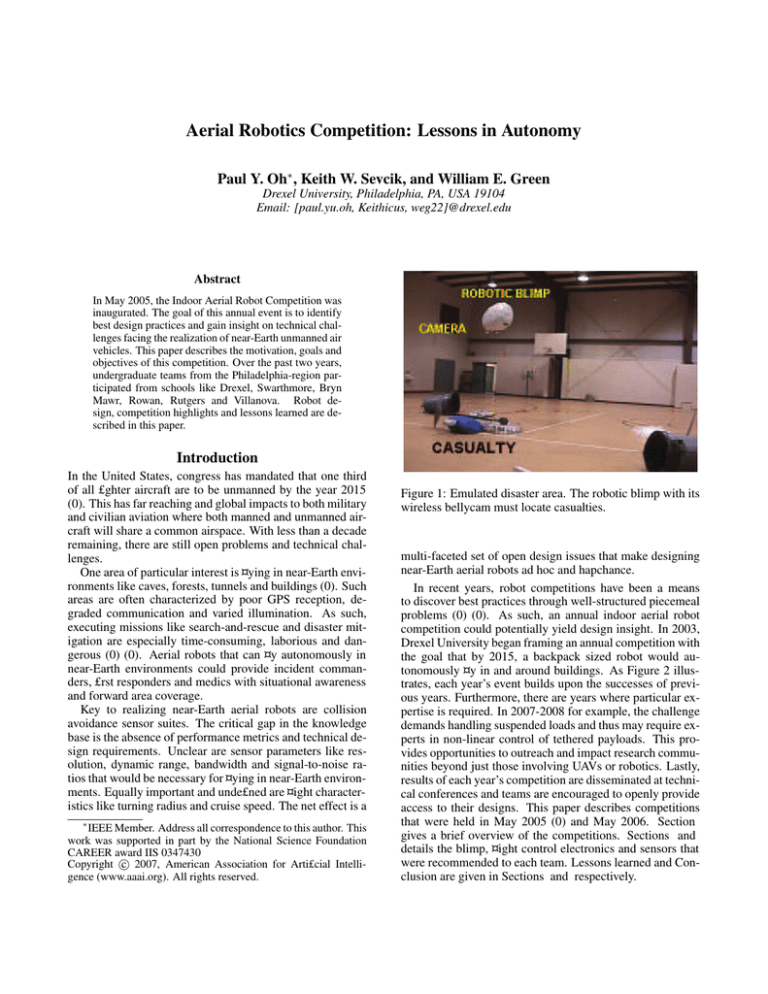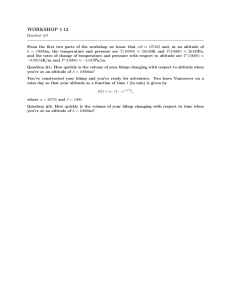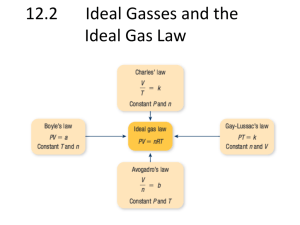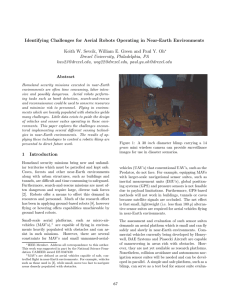
Aerial Robotics Competition: Lessons in Autonomy
Paul Y. Oh∗ , Keith W. Sevcik, and William E. Green
Drexel University, Philadelphia, PA, USA 19104
Email: [paul.yu.oh, Keithicus, weg22]@drexel.edu
Abstract
In May 2005, the Indoor Aerial Robot Competition was
inaugurated. The goal of this annual event is to identify
best design practices and gain insight on technical challenges facing the realization of near-Earth unmanned air
vehicles. This paper describes the motivation, goals and
objectives of this competition. Over the past two years,
undergraduate teams from the Philadelphia-region participated from schools like Drexel, Swarthmore, Bryn
Mawr, Rowan, Rutgers and Villanova. Robot design, competition highlights and lessons learned are described in this paper.
Introduction
In the United States, congress has mandated that one third
of all £ghter aircraft are to be unmanned by the year 2015
(0). This has far reaching and global impacts to both military
and civilian aviation where both manned and unmanned aircraft will share a common airspace. With less than a decade
remaining, there are still open problems and technical challenges.
One area of particular interest is ¤ying in near-Earth environments like caves, forests, tunnels and buildings (0). Such
areas are often characterized by poor GPS reception, degraded communication and varied illumination. As such,
executing missions like search-and-rescue and disaster mitigation are especially time-consuming, laborious and dangerous (0) (0). Aerial robots that can ¤y autonomously in
near-Earth environments could provide incident commanders, £rst responders and medics with situational awareness
and forward area coverage.
Key to realizing near-Earth aerial robots are collision
avoidance sensor suites. The critical gap in the knowledge
base is the absence of performance metrics and technical design requirements. Unclear are sensor parameters like resolution, dynamic range, bandwidth and signal-to-noise ratios that would be necessary for ¤ying in near-Earth environments. Equally important and unde£ned are ¤ight characteristics like turning radius and cruise speed. The net effect is a
∗
IEEE Member. Address all correspondence to this author. This
work was supported in part by the National Science Foundation
CAREER award IIS 0347430
c 2007, American Association for Arti£cial IntelliCopyright gence (www.aaai.org). All rights reserved.
Figure 1: Emulated disaster area. The robotic blimp with its
wireless bellycam must locate casualties.
multi-faceted set of open design issues that make designing
near-Earth aerial robots ad hoc and hapchance.
In recent years, robot competitions have been a means
to discover best practices through well-structured piecemeal
problems (0) (0). As such, an annual indoor aerial robot
competition could potentially yield design insight. In 2003,
Drexel University began framing an annual competition with
the goal that by 2015, a backpack sized robot would autonomously ¤y in and around buildings. As Figure 2 illustrates, each year’s event builds upon the successes of previous years. Furthermore, there are years where particular expertise is required. In 2007-2008 for example, the challenge
demands handling suspended loads and thus may require experts in non-linear control of tethered payloads. This provides opportunities to outreach and impact research communities beyond just those involving UAVs or robotics. Lastly,
results of each year’s competition are disseminated at technical conferences and teams are encouraged to openly provide
access to their designs. This paper describes competitions
that were held in May 2005 (0) and May 2006. Section
gives a brief overview of the competitions. Sections and
details the blimp, ¤ight control electronics and sensors that
were recommended to each team. Lessons learned and Conclusion are given in Sections and respectively.
Figure 2: 15-year Competition Timeline
Competition Overview
In 2003, with support from the Philadelphia-region ASME, a
competition that involved school teams in the local area was
conceived. The idea was to keep the competition manageable in the £rst few years to assess outcomes and grow the
event accordingly. Blimps were used as the ¤ying platform
because it is affordable, safe and does not demand much ¤ying skill. The rationale was that blimps could serve as a
surrogate vehicle for identifying best practices and maturing sensor suites and algorithms. As Figure 2 illustrates, the
competition envisions replacing the blimp with rotorcraft in
2010, when suitable vehicles will likely be more available.
The inaugural competition was held at Swarthmore College in May 2005 and focused on understanding visualservoing and human-robot interaction. The competition
goals were simple line-following and teleoperation.
Teams had to implement a line-following algorithm in
real-time that was invariant to changing lighting conditions
(see Figure 3). Towards the end of the course, robots were
met with a low-speed fan to simulate wind disturbances.
Points were awarded based on how far through the course
robots were able to travel.
The other section of the competition consisted of several mock victims spaced out in a 90 × 50 square foot area
(see Figure 1). Using a wireless camera mounted on the
blimp’s gondola, teams utilized teleoperated control to identify survivors and deploy markers (symbolic of radio beacons). Blimp operators were only permitted to view video
images transmitted wirelessly from the blimp’s camera and
could not directly view the search area. Points in this section
Figure 3: Swarthmore College’s blimp following the
collision-free path.
were awarded based on the marker’s proximity to survivors.
Such goals served to establish the necessary computer vision software and wireless communication infrastructure to
be leveraged in future years. For example, the 2006 competition goals were map building and hover-and-stare (see
Figure 4). The software and hardware constructed in 2005
were useful for new teams to quickly ascend learning curves
and participate.
The budget for the competition was assisted by the ASME
Philadelphia Region. Each student team had a professor
who served as an advisor. The professor was given $400
to distribute to the team in any manner. Some used the
funds to treat the competition as part-time work. Others supplemented departmental contributions to purchase hardware
and software.
Competition rules, notional videos1 , parts lists and related
material were made available to all teams. In 2005, schools
that were involved included Swarthmore, Drexel, Villanova
and Rowan. The competition grew to more teams in 2006
with Drexel, Bryn Mawr, Rowan, Villanova and Rutgers.
The 2007 competition will likely involve additional area
schools, with goals in cargo-lift and perch-and-stare.
Figure 5: Blimp Diagram.
Platform
Helium is the most common gas used in blimps today, with
a lifting capacity of 1.02 kg/m3 at standard temperature and
pressure. The blimp holds roughly .17 m3 of helium, giving
it a theoretical lifting capacity of 174 g. Experimental results
show an actual lifting capacity of 200 g. The total mass
of the balloon, gondola, £ns and mounting tape is 135.8 g.
Therefore, the maximum payload that can be carried by the
blimp is 64.2 g. This is substantially greater than typical
near-Earth £xed- or rotary-wing micro air vehicles (MAVs),
making it an ideal platform for testing a variety of sensors.
The blimp has two electric motors with attached propellers positioned on the gondola which allow forward and
backward movement. These two motors can also pivot via a
radio-controlled (RC) servo to provide an upward or downward angle to the thrust vector, as depicted in Figure 5. This
allows the blimp to increase or decrease its altitude respectively. Yaw (i.e. rotation about the vertical axis) is controlled
by an electric motor and propeller placed in the blimp’s rear
£n.
The blimp that was used by Drexel University was obtained from Plantraco 2 , and was modi£ed with a small RC
receiver and a micro servo for altitude actuation. A speed
controller was added to give proportional control of the
speed of the blimp. Once manual control via the RC transmitter was established, a map of the channels was created,
and was inserted into the PC2RC program (described further
in Section ). With this, computer control was established. A
vision system, which consisted of a wireless camera whose
receiver was plugged into the computer, parsed the information for line-following. The output of this program was also
sent to PC2RC to actuate autonomous control.
1
Videos: http://www.mem.drexel.edu/aerialRobotics
2
http://www.plantraco.com
Figure 6: A schematic of the PC to RC circuit and the resulting PIC pin outs.
PC2RC
In order to allow the blimp to be autonomously controlled
by a ground-based PC, a PC-to-RC circuit (dubbed PC2RC)
was constructed (0). Figure 6 shows how the circuit is interfaced with the PC and a standard 4-channel RC transmitter. This setup allows digital commands sent from the PC to
be converted into Pulse Width Modulated (PWM) signals.
PWM signals can then be sent wirelessly to the blimp’s onboard receiver.
The control software running on the PC generates 8-bit
numbers for each of the 4 channels on the transmitter. The
numbers correspond to the length of the PWM signal. Pulse
lengths vary from 1 to 2 ms, where 1.5 ms usually represents the neutral position of a RC servo. The microcontroller, integrated into the PC-to-RC circuit, receives the
numbers and generates the pulse to be sent to the RC transmitter. The pulses are grouped into frames, with a frame
containing one pulse for each channel.
The frames sent from the microcontroller are received
through the buddy port on the transmitter. Traditionally, the
buddy port is used to allow a trainer to take over the control
of an amateur under their tutelage (see Figure 7). This port
can also be used to allow the computer to take control of the
transmitter. Autonomous control can then be achieved based
on information gathered about the surrounding environment.
Sensors
The blimp’s intelligence is obtained via a wireless onboard
camera which transmits a video stream back to a computer
Figure 4: 2006 Competition: Maze navigation notion (top left) was physically realized in the Drexel Gymnasium (top middle).
Props for the hover-and-stare stage of the competition were also constructed (top right). Drexel’s entry navigating in the maze
with visual £ducials on the ¤oor (bottom left). The blimp was controlled from a ground station that displays the vehicle’s
on-board camera (bottom middle). Bryn Mawr’s blimp in the hover-and-stare stage of the competition (bottom right).
Figure 7: A PC-to-RC circuit converts digital commands to
RC signals. Commands are then sent wirelessly to the blimp
through a RC transmitter.
that processes image data and issues proper control commands. The video and transmitter are constructed as a
lightweight package, making it ideal for use in near Earth
aerial robotics. Integrating such hardware can produce a robust sensor suite for near-Earth environments.
To perform line-following, a wireless image acquisition
system is required. RC Toys’ Eyecam 3 provides a reliable wireless video feed when utilized indoors. It is about
as small as a U.S. quarter coin, weighs just 15 grams and
transmits color video on at 2.4 GHz. The output from the
receiver is composite video, which can be digitized with
Hauppauge’s USB-Live 4 in order to plug-and-play into a
PC.
To demonstrate line following, the blimp was placed over
a black line with a white background. A program was created to process the video feed. The video was then thresholded into a simple black and white image. To process the
code as fast as possible, thresholding was kept to every third
pixel. Code was written to calculate the location of the centroid of the line within the image plane. Line following code
consisted of thresholding the image coming in, calculating
the centroid of the entire image, and the centroid of the upper and lower halves. This information was used to generate
a line and calculate an angle. PD control was then implemented to direct the blimp along the line (see Figure 8). Debugging code was added to help discern situations where the
program would crash by visually indicating to the operator
3
4
http://www.rctoys.com/eyecam.php
http://www.hauppauge.com
cessing (e.g. object recognition) techniques to identify victims, tables, chairs, etc. During the teleoperated portion of
the course, one of the teams lost control of their blimp when
it was ¤own over a portion of the course that had been heated
by sunlight. This observation identi£ed thermals as a major
concern for aerial robots operating in near-Earth environments.
The lessons learned from past competitions include a mix
of technology from both teams. The most robust way to
control a blimp were concluded to be the Drexel University
set up, in which twin propellers were actuated via a servo
and turning was propelled by a rudder propeller. For radio
communications, the PC2RC circuit proved to be the championed method, as it provided easy to implement PC control.
Conclusions
Figure 8: A wireless camera is coupled with a computer vision algorithm to achieve line following.
if the angles became too steep or if a division by zero occurred. Using this knowledge, we are able to optimize the
controller and the program to keep from straying to these
unruly angles. Realistically, such ideal environments will
not be encountered. However, the same path following techniques can be applied if the location of the blimp is known.
Further, this sensing technology can be applied to near Earth
UAV’s with GPS access which can use objects such as roads
and rivers to navigate.
Lessons Learned
The dif£culty of the line following section was evident after
practice runs for each team. To compensate for this, each
team was allotted two restarts (i.e. the blimp can be placed
back in the position it last lost the line). With the incorporation of this rule, both teams were able to follow the line until
reaching the fan area, a distance of 75 feet. Once confronted
with low speed wind currents, each team’s blimp was immediately blown off course, unable to demonstrate gust stabilization. The target identi£cation task also proved to be dif£cult. Teams were only able to locate and mark 1 to 4 victims
out of a possible 8. In addition to the scores accumulated
in the collision avoidance and target identi£cation sections,
each team was also judged on the design of both the ¤ight
system and the marker deployment mechanism. The overall
winner of the 2005 competition was Drexel University.
The key challenges identi£ed in the inaugural competition were found mostly in the line following section. For example, sunlight shined sporadically on the course resulting
in large gradients which effected the ef£ciency of the computer vision algorithms. Also, wireless video transmission
indoors is diminished, but still usable at short distances (i.e.
less than 100 feet). Furthermore, stabilizing an aerial robot
in the presence of wind gusts is still a prevalent challenge.
In the teleoperated portion of the competition, teams
found it dif£cult to interpret the raw video transmitted from
the blimp’s wireless camera. A bird’s eye view is oftentimes
unfamiliar to the operator and may require some image pro-
The design of a sensor suite for a micro air vehicle varies
greatly from the sensor suites utilized on traditional UAVs.
Flying below tree tops or in and around urban structures
prevents the use of GPS. Furthermore, devices such as
IMU’s and gyros often strain the payload capacities of small,
lightweight aircraft. Design then focuses on achieving fundamental autonomous tasks such as altitude control and obstacle avoidance using the smallest packages possible. However, even the most highly-developed control system will fail
when presented with unforeseen obstacles. Telephone wires,
for example, are extremely thin, but could easily be fatal to
a MAV. Such near-Earth environment impediments demand
the use of varied sensing technologies to ensure robustness.
Through fusion of optic ¤ow sensing, vision based guidance
and wireless network localization, aerial vehicles are provided with a diverse sensor suite capable of addressing the
issues faced.
This paper demonstrates the porting of these techniques
onto a robotic blimp, which provides a robust, versatile platform with dynamics that can be characterized and modelled.
To begin to characterize these sensor suites, future work
must be conducted to measure the reactions of these sensors to variables introduced in a controlled near-Earth environment. To facilitate controller design, experimental results must be duplicated in simulated models. With well
understood models and corroborating physical data, design
can then move towards making MAV’s fully autonomous in
near-Earth environments.
Acknowledgements: The author would like to acknowledge the following professors who participated in the 2005
and 2006 competitions: Bruce Maxwell (Swarthmore),
Hong Zhang (Rowan), Rungan Nathan (Villanova), Peng
Song (Rutgers) and Doug Blank (Bryn Mawr). Additionally,
the following Drexel students played key roles in organizing
and executing the competition: William Green, Keith Sevcik, Vefa Narli, Dan Hanna, Steve Wilrigs and Paul Gisondi.
References
Blitch, J., “World Trade Center Search-and-Rescue Robots”, Plenary Session IEEE Int Conf Robotics and Automation, Washington D.C., May 2002.
Floyd D. Spence National Defense Authorization Act for Fiscal
Year 2001, P.L. 106-398 Sec 220.
Green, W.E., Sevcik, K.W., Oh, P.Y., “A Competition to Identify
Key Challenges for Unmanned Aerial Robots in Near-Earth Environments”, IEEE International Conference on Advanced Robotics
(ICAR), Seattle, WA, pp. 309-315, July 2005.
Kitano, H.; Asada, M.; Noda, I.; Matsubara, H., “RoboCup: robot
world cup”, IEEE Robotics and Automation Magazine, V5, N3,
pp. 30-36, September 1998.
Murphy, R., et al, “Mobility and sensing demands in USAR”,
IEEE Industrial Electronics Conference (IECON), V1, pp. 138142, 2000.
Murray, R.M., “Autonomous Machines: Racing to Win the
DARPA Grand Challenge”, Proc. American Control Conf., Portland, OR, pp. 9-10, June 2005.
Oh, P.Y., Green, W.E., “Closed Quarter Aerial Robot Prototype
to Fly In and Around Buildings”, Int. Conference on Computer,
Communication and Control Technologies, Orlando, FL, pp. 302307, July
Sevcik, K., Oh, P. “PC to RC Interface”, Servo Magazine, July
2004





